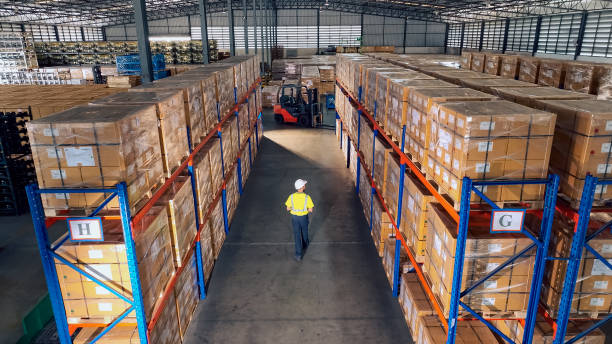With digitalization playing a pivotal role in the success of businesses, you must adapt and anticipate the future. But managing inventory is a complex task that needs careful planning and execution — the latest trends in inventory management can help guide strategic decisions.
These new trends in inventory management offer a world of possibilities: smoother supply chains, lower costs, happier customers, and a stronger market presence. So, let’s jump in and discover the game-changing trends that will revolutionize your inventory management strategies this year.
What is Inventory Management?
Inventory management is a vital process in supply chain operations that enables companies to determine the appropriate timing and quantities of stock to order. It involves:
- Tracking inventory from purchase to sale
- Responding to market trends
- Ensuring sufficient stock is available
This is to fulfill customer orders while providing early warning of potential shortages. Efficient inventory management is crucial as excessive stock ties up cash and reduces cash flow, whereas insufficient stock can lead to missed sales opportunities.

What are Inventory Models, and Why are they Important?
Inventory models are crucial in effective inventory management by helping businesses determine the optimal production and stock control approach. These models govern various aspects, such as:
- Ordering frequency for raw materials and MRO stock
- Storage of items in production or transit
- Efficient order fulfillment for customers
Commonly used inventory models include Economic Order Quantity (EOQ), Just-in-Time (JIT), and ABC analysis. Implementing these models offers several benefits, including improved demand forecasting, reduced stockouts, and optimized inventory replenishment.
Businesses can maximize resources, manage costs, and deliver quality goods to customers on time by understanding and utilizing these inventory models.

Top 15 Inventory Management Trends in 2023
Embracing the top 15 trends in 2023 enables companies to optimize inventory control, enhance efficiency, and meet evolving customer needs. Here are the top trends:

Artificial Intelligence (AI)
Artificial Intelligence and ML technologies are crucial in modern warehouses and inventory management. This AI plays a crucial role in effectively managing excess and obsolete inventory for businesses. However, the data collected by manufacturers and retailers often lack structure, such as:
- Product images
- Videos
- Diverse SKU formats
With machine learning, it becomes possible to identify defective products or packaging, ensuring customers receive only high-quality items. Moreover, inventory data continuously expands and evolves, further complicating the analysis process.

Better Automated Systems
Businesses are turning to automated guided vehicles (AGVs) and mobile robots (AMRs) to meet the demand for faster deliveries.
While AGVs follow fixed paths using magnetic strips or wires, AMRs are collaborative robots equipped with smart sensors, allowing them to navigate without fixed routes and work alongside humans.
Both vehicles enhance warehouse efficiency, speeding up item movement and freeing up human staff for other tasks. AMRs, without the need for additional infrastructure, offer a cost-effective and easily deployable solution.

Real-time Inventory Visibility
Key aspects of effective inventory management include minimizing gross margin/inventory cost by:
- Reducing holding costs
- Addressing shrinkage caused by lost, stolen, or damaged products
- Improving sell-through rates by operating with less stock
- Increasing stock turn to enhance cost efficiency
- Monitoring product performance to meet customer expectations and
- Preventing lost sales or stockouts due to the unavailability of in-demand products.
These inventory management strategies contribute to streamlined inventory management and improved business outcomes.

Demand Sensing and Forecasting
Demand sensing combines methodology and technology to predict short-term demand based on recent data, allowing for accurate predictions in a volatile market.
It utilizes short-term trends to anticipate market changes, enhancing supply chain resilience. By providing daily demand data, demand sensing improves inventory management, optimizing levels and reducing costs while maintaining resilience.
It leverages various signals to gain early insights into trends, enhancing predictability by considering real-world events such as order patterns, retail sales, promotions, and market changes.

Data Analytics for Predictive Picking
The use of unstructured data analysis is a growing trend in predicting customer behavior and optimizing order fulfillment. Predictive picking software leverages various data, such as:
- Marketing plans
- Weather patterns
- Seasonality
These accurately anticipate customer orders. While implementing this trend may seem complex, starting with historical data analysis to identify demand surges and understanding their underlying causes can be a practical first step.
Businesses can minimize shipping times and touches by having sufficient stock and streamlining fulfillment processes based on these insights.

Personalization
A robust system utilizes personalization data to increase sales. For instance, a retailer suggests additional products during online browsing or checkout, while a manufacturer stocks complementary items like maintenance kits. Personalization data sources include:
- Demographic/persona information.
- Company data (e.g., employee count, revenue, industry).
- Behavioral data (e.g., first-time vs repeat buyer, order history).
- Contextual data (e.g., time of visit, a device used).

Third-party logistics (3PL)
Third-party logistics (3PL) involves outsourcing distribution, warehousing, and related activities to an external provider.
This enables businesses to expand their customer reach and operate efficiently without the expense of developing infrastructure.
The crucial factor for 3PL’s success is establishing seamless connectivity across all production sites, including the manufacturer and 3PL provider, to ensure they function as an integrated supply chain.

Multiple Warehousing
Distributed inventory management requires multiple regional locations, enabling streamlined supply chains and faster deliveries. It facilitates scalability, crisis handling, and cost reduction.
Leading e-commerce and online marketplace companies have adopted this approach, encouraging others to do the same. Multi-location warehouses were crucial during the pandemic and remain valuable for emergencies.
Cloud technology is essential for enabling this system, with advanced and cost-effective inventory management software available

Hybrid Warehousing & Shipping
Some big box stores have repurposed unused space as drop-ship locations, utilizing space efficiently but requiring retail employee retraining.
Retailers have partnered with third-party logistics providers (3PLs) to store inventory and directly ship orders to customers, adding a hybrid element to traditional warehousing and shipping.
Drop shipping, where retailers pay manufacturers to ship items directly to customers, can also have a hybrid aspect when retailers stock a few popular drop-shipped items to offer premium shipping options.

Omni-channel Inventory Management
Omni-channel inventory control involves aligning online and physical stores, ensuring availability and consistent pricing. It requires coordination among stores, distribution centers, and e-commerce operations.
By integrating inventory data from various channels into a centralized system, businesses can accurately allocate inventory based on demand, prevent stockouts, reduce overstocking, and provide a seamless shopping experience for customers across different platforms, ultimately leading to improved customer satisfaction and increased sales.
Price and discount parity are crucial to avoid customer dissatisfaction. An omnichannel strategy is essential for competitiveness, requiring a connected supply chain, real-time inventory reconciliation, demand planning, accurate order fulfillment, data analytics, and nearby distribution centers.

Vendor-managed Inventory (VMI)
It is an inventory management technology system where the seller manages inventory instead of the buyer. With VMI, the retailer no longer needs to actively order inventory as the vendor monitors inventory levels and determines when restocking is required.
VMI aims to reduce inventory costs for both parties. By allowing suppliers to manage inventory, overstocking is minimized, resulting in cost savings for the retailer.

Blockchain Technology
Blockchain enables transparency through a distributed ledger accessible to the public or private consortium. Numerous companies have embraced blockchain for inventory management.
Deloitte predicts the emergence of the blockchain decade, highlighting innovative use cases such as securing AP loans.
The life sciences and healthcare industry lead blockchain adoption, leveraging it for clinical trials and digitizing health records.

Safety Stock
Safety stock is a buffer to safeguard against unforeseen spikes in demand, production disruptions, or delays in receiving ordered goods. It enables us to meet production and sales demands until new stock is obtained or manufactured.
Ensuring business continuity allows companies to continue selling during supply chain or production disruptions and unexpected demand situations.
The significance of safety stock has grown significantly in the aftermath of the COVID-19 pandemic, leading more companies to maintain a protective buffer.

Sustainable Inventory Practices
Artificial Intelligence, Advancements in IoT, and cloud capabilities enable improved communication within inventory management networks.
Implementing multi-warehousing and decentralization methods reduces reliance on specific regions, resulting in more resilient and sustainable supply chain processes for businesses and industries

Investing in an Inventory Manager
Adopting technology in inventory management has revolutionized how this function is approached. Managers must upgrade their skills and adapt to new technology for inventory management.
To ensure the proficient handling of modern systems, companies invest significantly in training programs, courses, seminars, and certifications for their managers. It enables companies to maximize the benefits of their technology investments.

Boost your Inventory Management Success with Hopewell Logistics!
In today’s rapidly evolving business landscape, efficient inventory management is crucial for maintaining a competitive edge. You can streamline your operations and achieve optimal results by leveraging the right tools, techniques, and the latest inventory management trends that align with your specific business needs.
At Hopewell Logistics, we understand the complexities of inventory management and have established ourselves as industry leaders. Our extensive expertise can empower you to unlock the full potential of your operations and drive success.
Contact us today for expert guidance and support in implementing effective inventory management strategies.






